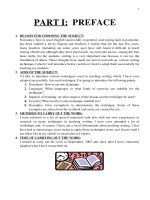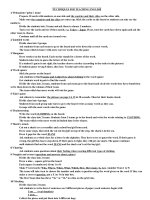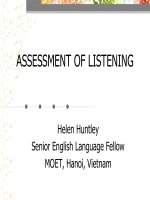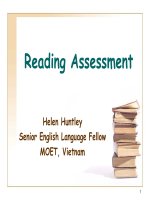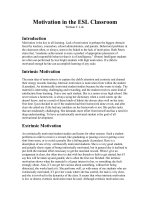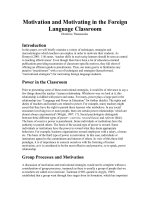- Trang chủ >>
- Sư phạm >>
- Quản lý giáo dục
classroom assessment techniques
Bạn đang xem bản rút gọn của tài liệu. Xem và tải ngay bản đầy đủ của tài liệu tại đây (87.33 KB, 6 trang )
Classroom
Assessment
Techniques
taken
from
Classroom
Assessment
Techniques:
A
Handbook
for
College
Teachers,
2nd
edition
by
Thomas
A.
Angelo
&
K.
Patricia
Cross
<><><><><><><><><><><><><><><><><><><><><><><><>
• Learning
can
and
often
does
take
place
without
the
benefit
of
teaching
–
and
sometimes
even
in
spite
of
it
–
but
there
is
no
such
thing
as
effective
teaching
in
the
absence
of
learning.
Teaching
without
learning
is
just
talking.
(p.
3)
• Classroom
Assessment
is
an
approach
designed
to
help
teachers
find
out
what
students
are
learning
in
the
classroom
and
how
well
they
are
learning
it.
Characteristics
of
Classroom
Assessment:
(pp.
4
–
7)
Learner‐Centered
–
its
focus
is
on
observing
and
improving
learning,
rather
than
on
observing
and
improving
teaching
Teacher‐Directed
–
the
individual
teacher
decides
what
to
assess,
how
to
assess,
and
how
to
respond
to
the
information
gained
through
the
assessment
Mutually
Beneficial
–
students
reinforce
course
content
and
strengthen
their
self‐
assessment
skills;
faculty
sharpen
their
teaching
focus
by
asking
3
questions:
“What
are
the
essential
skills
and
knowledge
I
am
trying
to
teach?”,
“How
can
I
find
out
whether
students
are
learning
them?”,
and
“How
can
I
help
students
learn
better?”
Formative
–
its
purpose
is
to
improve
the
quality
of
student
learning,
not
to
provide
evidence
for
evaluating
or
grading
students;
it
provides
information
on
what,
how
much,
and
how
well
students
are
learning
Context‐Specific
–
the
assessment
technique
is
chosen
to
fit
the
subject
matter
and
the
needs
of
the
particular
class
Ongoing
–
it
is
an
ongoing
process,
i.e.
the
creation
and
maintenance
of
a
classroom
“feedback
loop”;
as
this
approach
becomes
integrated
into
everyday
classroom
activities, the communications loop between faculty (teaching) and students (learning)
becomes more efficient and effective; it provides early feedback – before students are
evaluated for grades – so that necessary adjustments can be made
• Effective assessment begins with clear goals. It usually takes some hard thinking before
teachers can articulate the specific skills and competencies they hope to teach through the
course content – what is most important to teach and what students should really learn.
Classroom Assessment Techniques give faculty feedback on how well they are achieving
their teaching goals. (pp. 8 – 9)
page 1
prepared by S. Gaulden, 08‐2010
• Teaching goals fall into 6 categories: (p. 17)
1) Higher‐Order Thinking Skills
2) Basic Academic Success Skills
3) Discipline‐Specific Knowledge and Skills
4) Liberal Arts and Academic Values
5) Work and Career Preparation
6) Personal Development
• Summative versus Formative Evaluations: (p. 25)
Summative
Formative
Purpose: to make judgments about
individual student achievement & assign
grades
Purpose: to inform teaching & improve
learning; used as “feedback devices”
Examples: quizzes, tests, exams; term
papers, lab reports, homework
Examples: pose questions, listen to
students questions & comments, monitor
body language & facial expressions,
Classroom Assessment Techniques
• Implementation of Classroom Assessment Techniques – tell the students why you are
asking them for information, i.e. you will be assessing their learning in order to help them
improve and not to grade them; usually ask for anonymous responses; teach them how to
do the assessment before applying it; let them know what you learned and what difference
that information will make, i.e. how you will change your teaching/the class to respond to
the information they provided, so they know that their participation in the Classroom
Assessment can have a positive impact on your teaching and their learning (pp. 29 – 30)
• Several Classroom Assessment Techniques (arranged by category)
ASSESSING COURSE‐RELATED KNOWLEDGE AND SKILLS
ASSESSING PRIOR KNOWLEDGE, RECALL, AND UNDERSTANDING (pp. 119 – 158)
Minute Paper – ask students to answer the question “What was the most important
thing you learned during this class?” or “What important question remains
unanswered?” in the last 5 minutes of class; students must self‐assess to answer
either question; faculty collect written feedback on student learning; problem
points can be shared and addressed at the beginning of the next class
Muddiest Point – ask students to write a quick response to the question “What was
the muddiest point in _____?” (where _____ = the lecture, discussion, homework
assignment, etc.) at the end of the _____; students must articulate what they do
page 2
prepared by S. Gaulden, 08‐2010
not understand immediately; faculty learn which points are most difficult for
students to learn and can clarify missed concepts right away
Background Knowledge Probe – ask students to answer 2 – 3 open‐ended or about
10 multiple choice questions that probe the students’ existing knowledge of that
concept, subject, or topic; faculty learn at what point to start teaching; the next
class can begin with students asked to answer the same questions working in
groups
ASSESSING SKILL IN ANALYSIS AND CRITICAL THINKING (pp. 159 – 180)
Defining Features Matrix – ask students to complete a table by checking off features
that distinguish between 2 or 3 similar concepts; faculty can pinpoint areas of
confusion quickly and address them right away; a simple example is given below
features
skin or fur
cold‐blooded
…
mammals reptiles
x
X
Pro & Con Grid – ask students to write the pros & cons of a given issue – a question
of value; forces students to analyze a situation and consider both sides; faculty can
assess students’ awareness of costs and benefits; sharing the results with the class
initiates discussion
ASSESSING SKILL IN SYNTHESIS AND CREATIVE THINKING (pp. 181 – 212)
One‐Sentence Summary – ask students to answer the questions “Who does what to
whom, when, where, how, and why?” about a given topic & then to synthesize
those answers into a single summary sentence; students practice “chunking
information”; faculty learn how concisely students can summarize lots of
information on a given topic; an example is given below
Who?
Does what?
To what/whom?
When?
Where?
How?
Why?
teachers
assess
their students’ learning
regularly during the
semester
in the classroom
using Classroom
Assessment Techniques
and other appropriate
evaluative instruments
so they can improve
teaching effectiveness &
student learning
1 sentence summary:
Teachers assess their students’
learning regularly during the
semester in the classroom using
Classroom Assessment Techniques
and other appropriate evaluative
instruments so they can improve
teaching effectiveness and student
learning.
Approximate Analogies – ask students to complete the second part of an analogy,
e.g. “The theme is to an essay as _____ is to _____” or “Mass is to volume as
_____ is to _____” in a few minutes; students can connect the new relationship to
page 3
prepared by S. Gaulden, 08‐2010
one they are already familiar with which helps them retain knowledge; present
the best responses to the class as good examples
ASSESSING SKILL IN PROBLEM SOLVING (pp. 213 – 230)
Problem Recognition Tasks – ask students to recognize and identify the particular
type of problem given examples represent; helps students focus on diagnosing the
problem first rather than rushing to try to solve it; helps faculty assess how well
students can recognize various problem types, the first step in matching problem
type to solution method; e.g. in psychology – given 6 case studies, identify
whether each scenario represented substance abuse, family conflicts, depression,
or academic stress
Documented Problem Solutions – ask students to solve 2 or 3 problems (easy
difficult) and briefly explain each solution step in writing; students learn to keep
track of the steps; teachers can gain insight into the students’ problem‐solving
skills – the explanation of the steps (the process) is emphasized not the actual
solution (the product)
ASSESSING SKILL IN APPLICATION AND PERFORMANCE (pp. 231 – 253)
Directed Paraphrasing – ask students to paraphrase part of a lesson for a specific
audience and purpose using their own words; students develop the valuable skill
of translating information into words they can understand; faculty can assess how
well students have understood and internalized the learning; successful
paraphrases can be shared with the class; e.g. in nursing – in one or two
sentences, paraphrase what you have learned about hospice care to inform a
dying, but still lucid, patient of its possible advantages over hospital or home care
Applications Cards – ask students to write down one possible, real‐world application
of what they have just learned; students connect newly learned concepts with
prior knowledge and see the relevance of what they are learning; faculty can share
great examples with the class to initiate current discussions; students may work in
or share with small groups
ASSESSING LEARNER ATTITUDES, VALUES, AND SELF‐AWARENESS
ASSESSING STUDENTS’ AWARENESS OF THEIR ATTITUDES AND VALUES (pp. 257 – 279)
Classroom Opinion Polls – ask students to agree or disagree with a statement;
students discover their own opinions about issues and compare them against
others’ opinions; faculty can be aware of pre‐existing opinions that might interfere
with learning; polling can be used as a pre‐ and post‐assessment technique to
determine whether and how students’ opinions have changed in response to class
discussions and assignments; can share tabulated data to initiate discussion; an
Anthropology example is given below
Native Americans who stay on the reservation are better off than those who leave
Circle one: Strongly Disagree Disagree Don’t Know Agree Strongly Agree
page 4
prepared by S. Gaulden, 08‐2010
Course‐Related Self‐Confidence Surveys – ask students to answer a short survey
describing how confident they are in various skill areas; students can ‘own’ their
level of confidence and work to improve it; faculty can more effectively structure
assignments to build confidence and enhance motivation and learning since low
self‐confidence often impedes learning; faculty can share survey results with the
class and ask students for suggestions on ways to improve self‐confidence and
performance; use these surveys before the skills in question are introduced and
again after students are likely to have made significant progress toward mastering
them
ASSESSING STUDENTS’ SELF‐AWARENESS AS LEARNERS (pp. 280 – 298)
Interest/Knowledge/Skills Checklists – ask students to rate their interest and assess
their levels of knowledge or skill in various topics by indicating responses on
checklists; students can discover mismatches or good fits between their interest
and skills; faculty can plan and adjust their teaching agendas; most useful with
courses that have flexible content; can be administered pre‐ and post‐course to
show changes in interest and knowledge or skill levels
Self‐Assessment of Ways of Learning – ask students to complete a Learning Styles
inventory/test such as VARK; students learn how they best intake information and
can implement better study methods; after reviewing student learning styles,
faculty can choose appropriate instructional approaches; extremely useful in
developmental education courses so that students improve their study skills early
on in their college careers
ASSESSING COURSE‐RELATED LEARNING AND STUDY SKILLS, STRATEGIES & BEHAVIORS (pp. 299 – 315)
Punctuated Lectures – ask students to listen to a lecture or demonstration then, after
a portion of the lecture/demo has been completed, the instructor stops and the
students spend a few minutes writing down what they were doing during the
presentation and any insights they gained; students realized how they are
processing or failing to process presented information and how their behavior is
influencing that processing – they may be more apt to self‐monitor; faculty see
how well students are processing information; distractions will become apparent
to both students and faculty; examples of questions to ask are given below
How fully and consistently were you concentrating on the lecture? Were you distracted at any
point?
What were you doing to record the information you were receiving? How successful were you?
What do you expect to come next in the lecture and why?
ASSESSING LEARNER REACTIONS TO INSTRUCTION
ASSESSING LEARNER REACTIONS TO TEACHERS AND TEACHING (pp. 320 – 342)
Chain Notes – ask students to put their response to a question – e.g. “Immediately
before this reached you, what exactly were you doing/paying attention to?” – the
teacher has written on a large envelope about the class in the envelope as it is
passed around the class; students must self‐assess the moment they receive the
page 5
prepared by S. Gaulden, 08‐2010
envelope what they were paying attention to/what are they learning right now –
they may gain control over their behavior; faculty get a sense of the students’
level of engagement and involvement; results can be shared and suggestions can
be solicited from the class
E‐mail Feedback – ask students to respond via e‐mail to a question e‐mailed to them
regarding the instructor’s teaching, e.g. “What is one small change I could make
that would help you learn more effectively in this class?” or “If you were the
teacher of this class, what would you do to make the assignments more useful?”;
students become used to using their e‐mail and get to respond outside of class;
faculty receive information on their teaching and can make necessary adjustments
quickly
ASSESSING LEARNER REACTIONS TO CLASS ACTIVITIES, ASSIGNMENTS, AND MATERIALS (pp. 343 – 361)
Reading Rating Sheets – ask students to complete a survey on given activity, reading
assignment, etc.; students get to evaluate the assignments made or the materials
used in class; faculty can adjust their selection of assignments or materials as
necessary based on student feedback; questions to include on the survey might
include the following: How useful was the reading in improving your vocabulary
and reading skill? How interesting was the reading to you? Would you
recommend it to a friend – why or why not? What did you learn from it that you
want to make sure to remember?
Exam Evaluations – ask students to write their reactions to tests and exams; students
feel that their input matters; faculty receive feedback so they can make the exams
more effective as learning and assessment devices; this assessment can be
included at the end of the actual exam when it is given to the class or can given
soon after the exam is taken
• Analysis of Classroom Assessment Data – try to answer some of the following questions:
(pp. 53 – 54)
Questions About Your Students
How many students are learning well & how many are not?
Which students are learning well & which are not?
What do successful learners do that other learners don’t do, or don’t do as well?
If students did poorly, why (instructional methods, poor learning skills, …)?
Questions About Course Content
How much of the course content are students learning?
Which elements of the course content are students learning?
Questions About Teaching
How does my teaching affect student learning, positively and negatively?
What, specifically, could I change about my teaching to improve learning inside &
outside the classroom?
• Results of Classroom Assessment can provide the impetus for trying different things to
improve learning. (p. 49)
page 6
prepared by S. Gaulden, 08‐2010
